0 引言
1 区域地质背景
2 样品与实验方法
表1 鄂尔多斯盆地东部本溪组铝土岩系及相邻岩石的稳定微量元素特征Table 1 Stable trace element characteristics of bauxite rock series and adjacent rocks in the Benxi Formation in the eastern Ordos Basin |
| 井号 | 样品编号 | 深度/m | 岩性 | 微量元素/10-6 | Zr/Nb | Zr/Hf | |||||||
|---|---|---|---|---|---|---|---|---|---|---|---|---|---|
| Nb | Zr | Hf | Ta | Cr | Th | Ni | U | ||||||
| M119 | M119-1 | 3 047.52 | 泥质铝土岩 | 78.1 | 744.0 | 20.5 | 5.7 | 181.0 | 75.7 | 66.9 | 35.4 | 9.5 | 36.4 |
| M119-2 | 3 047.79 | 铝土岩 | 93.9 | 858.0 | 23.6 | 7.0 | 230.0 | 92.9 | 95.0 | 33.4 | 9.13 | 36.4 | |
| M119-3 | 3 048.42 | 铝土岩 | 81.2 | 725.0 | 19.8 | 6.2 | 225.0 | 107.0 | 91.6 | 42.9 | 8.9 | 36.5 | |
| M119-4 | 3 049.01 | 泥质铝土岩 | 66.7 | 585.0 | 16.2 | 5.0 | 206.0 | 94.5 | 73.5 | 29.7 | 8.8 | 36.0 | |
| M119-5 | 3 049.5 | 铁铝岩 | 37.6 | 333.0 | 9.2 | 2.7 | 138.0 | 55.6 | 50.9 | 19.9 | 8.9 | 36.2 | |
| M119-6 | 3 049.67 | 铁铝岩 | 47.3 | 406.0 | 11.6 | 3.5 | 171.0 | 74.9 | 66.5 | 21.0 | 8.6 | 35.0 | |
| M119-7 | 3 050.17 | 泥岩 | 45.2 | 418.0 | 12.0 | 3.3 | 181.0 | 73.6 | 70.5 | 20.4 | 9.3 | 35.0 | |
| M119-8 | 3 050.48 | 泥岩 | 42.7 | 482.0 | 13.2 | 3.1 | 143.0 | 62.3 | 53.0 | 30.0 | 11.3 | 36.5 | |
| M119-9 | 3 050.99 | 泥岩 | 42.7 | 334.0 | 9.3 | 3.1 | 121.0 | 56.5 | 40.8 | 16.3 | 7.8 | 36.0 | |
| M119-10 | 3 051.4 | 角砾白云岩 | 17.1 | 132.0 | 3.5 | 1.2 | 47.1 | 23.4 | 14.5 | 14.1 | 7.7 | 37.5 | |
| Q30 | Q30-1 | 2 872.6 | 砂岩 | 7.0 | 124.0 | 3.4 | 1.0 | 36.5 | 5.1 | 7.7 | 1.9 | 17.8 | 37.0 |
| Q30-2 | 2 872.8 | 砂岩 | 7.3 | 124.0 | 3.6 | 1.0 | 38.7 | 5.5 | 8.6 | 2.4 | 16.9 | 34.8 | |
| Q30-3 | 2 874.08 | 泥岩 | 43.9 | 448.0 | 12.4 | 3.0 | 137.0 | 33.5 | 28.5 | 15.2 | 10.2 | 36.1 | |
| Q30-4 | 2 875.2 | 泥质铝土岩 | 88.8 | 722.0 | 20.0 | 6.3 | 235.0 | 116.0 | 94.1 | 47.1 | 8.1 | 36.1 | |
| Q30-5 | 2 875.22 | 泥质铝土岩 | 88.0 | 739.0 | 20.4 | 6.6 | 234.0 | 119.0 | 87.0 | 47.8 | 8.4 | 36.1 | |
| Q30-6 | 2 876.8 | 泥质铝土岩 | 81.4 | 636.0 | 17.6 | 5.8 | 218.0 | 108.0 | 92.3 | 27.4 | 7.8 | 36.1 | |
| Q30-7 | 2 877 | 泥质铝土岩 | 72.8 | 597.0 | 16.4 | 5.2 | 217.0 | 95.0 | 71.0 | 23.3 | 8.2 | 36.5 | |
| Q30-8 | 2 877.69 | 泥岩 | 57.9 | 435.0 | 11.5 | 3.9 | 157.0 | 74.8 | 55.7 | 19.4 | 7.5 | 37.9 | |
| Q30-9 | 2 877.98 | 泥岩 | 38.7 | 340.0 | 9.1 | 2.9 | 106.0 | 53.3 | 46.4 | 24.0 | 8.8 | 37.4 | |
| Q30-10 | 2 878.27 | 泥岩 | 31.1 | 275.0 | 7.7 | 2.2 | 78.9 | 44.7 | 38.4 | 20.6 | 8.8 | 35.6 | |
| Q30-11 | 2 878.4 | 白云岩 | 6.8 | 66.3 | 1.8 | 0.5 | 22.0 | 9.9 | 8.4 | 9.8 | 9.8 | 37.7 | |
| Q30-12 | 2 878.6 | 白云岩 | 21.0 | 163.0 | 4.6 | 1.5 | 52.1 | 27.1 | 17.0 | 15.7 | 7.8 | 35.6 | |
| Q30-13 | 2 878.99 | 白云岩 | 1.4 | 11.5 | 0.3 | 0.1 | 5.1 | 1.4 | 1.4 | 3.3 | 8.1 | 36.9 | |
| Q36 | Q36-1 | 2 834.42 | 泥岩 | 38.9 | 575.0 | 15.6 | 2.7 | 152.0 | 35.5 | 48.3 | 12.7 | 14.8 | 36.8 |
| Q36-2 | 2 836.84 | 泥岩 | 43.5 | 378.0 | 10.2 | 3.2 | 139.0 | 55.5 | 54.1 | 19.0 | 8.7 | 37.2 | |
| Q36-3 | 2 837.54 | 泥岩 | 41.6 | 348.0 | 9.8 | 3.1 | 135.0 | 54.3 | 47.1 | 16.6 | 8.4 | 35.4 | |
| Q36-4 | 2 838.03 | 泥岩 | 47.0 | 378.0 | 10.8 | 3.4 | 132.0 | 56.0 | 50.1 | 15.3 | 8.0 | 35.1 | |
| S220 | S220-1 | 2 911.5 | 铝土岩 | 96.0 | 900.0 | 24.0 | 6.6 | 229.0 | 88.7 | 78.4 | 37.4 | 9.4 | 37.5 |
| S220-2 | 2 913.09 | 泥质铝土岩 | 56.3 | 477.0 | 13.3 | 4.1 | 138.0 | 60.6 | 51.6 | 25.9 | 8.5 | 35.9 | |
| S220-3 | 2 913.96 | 铝土岩 | 65.1 | 510.0 | 14.9 | 4.6 | 148.0 | 75.6 | 69.3 | 33.4 | 7.8 | 34.2 | |
| S220-4 | 2 914.32 | 铝土岩 | 79.7 | 696.0 | 18.9 | 5.9 | 186.0 | 97.0 | 69.1 | 32.2 | 8.7 | 36.8 | |
| S220-5 | 2 915.61 | 角砾白云岩 | 14.0 | 117.0 | 3.2 | 1.0 | 31.7 | 17.8 | 10.2 | 7.3 | 8.3 | 36.1 | |
| S464 | S464-1 | 3 309.16 | 铝土岩 | 105.0 | 919.0 | 25.6 | 7.3 | 227.0 | 108.0 | 98.4 | 53.5 | 8.8 | 35.9 |
| S464-2 | 3 309.51 | 铝土岩 | 102.0 | 872.0 | 24.5 | 6.9 | 228.0 | 97.0 | 103.0 | 57.1 | 8.6 | 35.6 | |
| S464-3 | 3 309.7 | 泥质铝土岩 | 103.0 | 861.0 | 24.4 | 7.2 | 216.0 | 100.0 | 82.6 | 43.4 | 8.4 | 35.3 | |
| S464-4 | 3 310 | 铝土质泥岩 | 93.9 | 767.0 | 21.5 | 6.5 | 188.0 | 95.3 | 63.0 | 35.1 | 8.2 | 35.6 | |
| S464-5 | 3 310.07 | 铝土质泥岩 | 62.2 | 538.0 | 15.2 | 4.4 | 136.0 | 73.1 | 52.5 | 23.1 | 8.7 | 35.4 | |
| S464-6 | 3 311.08 | 泥岩 | 47.2 | 422.0 | 11.9 | 3.4 | 115.0 | 55.2 | 50.2 | 22.9 | 8.9 | 35.3 | |
| S464-7 | 3 311.55 | 泥岩 | 42.0 | 381.0 | 10.6 | 3.0 | 122.0 | 57.3 | 37.7 | 38.8 | 9.1 | 36.0 | |
| S464-8 | 3 311.99 | 泥岩 | 21.4 | 181.0 | 4.9 | 1.5 | 44.7 | 23.5 | 15.8 | 10.1 | 8.5 | 37.0 | |
| S464-9 | 3 312.2 | 灰岩角砾 | 3.7 | 32.6 | 0.8 | 0.3 | 9.6 | 4.1 | 3.7 | 2.1 | 8.8 | 38.7 | |
| S464-10 | 3 313.13 | 灰岩角砾 | 1.9 | 14.4 | 0.4 | 0.1 | 6.2 | 2.0 | 2.1 | 1.2 | 7.6 | 39.5 | |
| S144 | S144-1 | 2 533.1 | 泥岩 | 39.9 | 677.0 | 18.7 | 2.9 | 141.0 | 29.0 | 57.8 | 9.5 | 17.0 | 36.2 |
| S144-2 | 2 535.07 | 泥岩 | 55.7 | 539.0 | 15.1 | 3.9 | 126.0 | 42.0 | 46.9 | 10.6 | 9.7 | 35.7 | |
| S144-3 | 2 536.1 | 泥岩 | 67.9 | 978.0 | 27.2 | 4.8 | 174.0 | 54.4 | 55.0 | 21.0 | 14.4 | 35.9 | |
3 实验结果
3.1 碎屑锆石形貌学与微量元素特征
图3 鄂尔多斯盆地东部本溪组铝土岩系及其上覆砂泥岩中碎屑锆石的形态和U-Pb年龄(a)上覆泥岩;(b)上覆砂岩;(c),(d)铝土岩系 Fig.3 Morphology and U-Pb ages of detrital zircons in the bauxite rock series and its overlying sandstones/mudstones in the Benxi Formation in the eastern Ordos Basin |
图4 鄂尔多斯盆地东部本溪组铝土岩系和上覆碎屑岩中碎屑锆石的粒径Fig.4 Particle sizes of detrital zircon in the bauxite rock series and its overlying detrital rocks in the Benxi Formation in the eastern Ordos Basin |
3.2 碎屑锆石年龄分布特征
3.3 全岩稳定微量元素特征
图7 鄂尔多斯盆地东部本溪组铝土岩系及相邻岩石的稳定微量元素Fig.7 Stable trace elements of bauxite rock series and its adjacent rocks in the Benxi Formation in the eastern Ordos Basin |
4 讨论
4.1 碎屑锆石的来源
4.2 稳定元素揭示的物质来源
4.3 盆地东部本溪组铝土岩系的物质来源
5 结论
(2)鄂尔多斯盆地东部本溪组铝土岩系上覆砂岩、泥岩中的碎屑锆石基本上为磨圆度较高的变质成因锆石,粒径为0.06~0.13 mm,谐和年龄占比低(±50%),年龄区间为2 600~2 300 Ma和2 100~1 700 Ma。这些碎屑锆石主要来自盆地北部的华北克拉通基底,在本溪组沉积期经长距离搬运后沉积于研究区铝土岩系之上。
(3)研究区本溪组铝土岩系富集稳定元素,Zr、Nb丰度明显高于下伏碳酸盐岩和上覆砂岩。铝土岩系的Zr/Nb值与下伏碳酸盐岩的Zr/Nb值基本一致,但与上覆碎屑岩、马家沟组凝灰岩的Zr/Nb值明显不同。



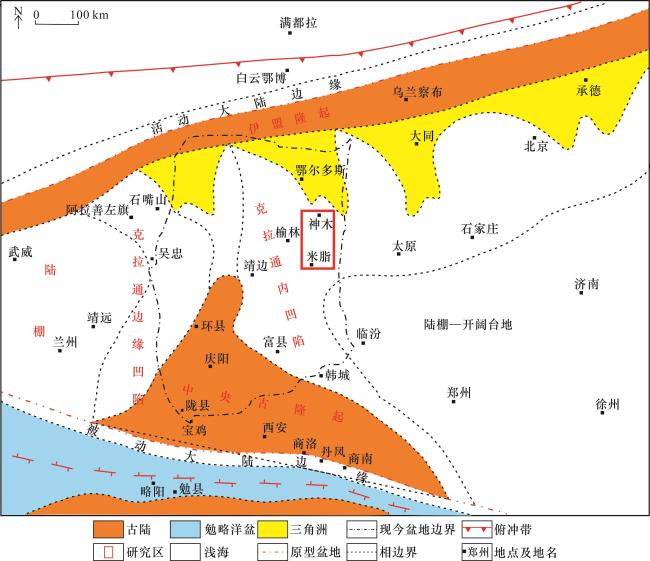
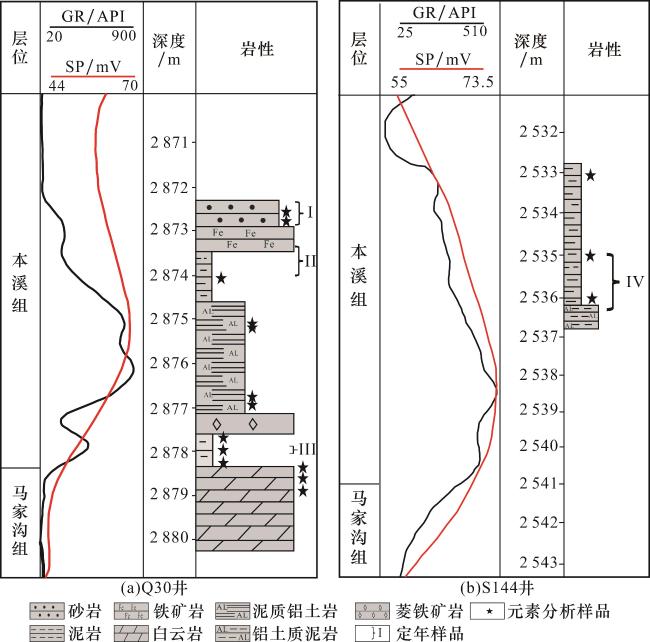
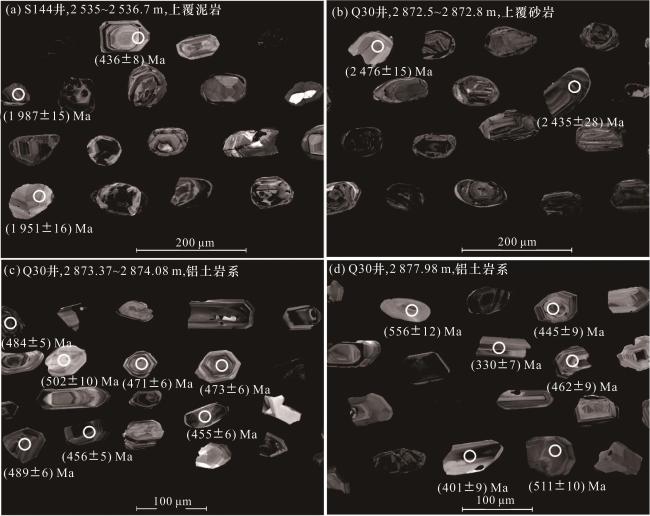
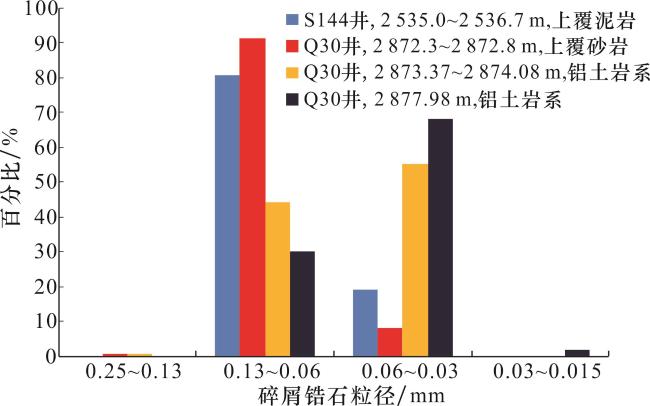
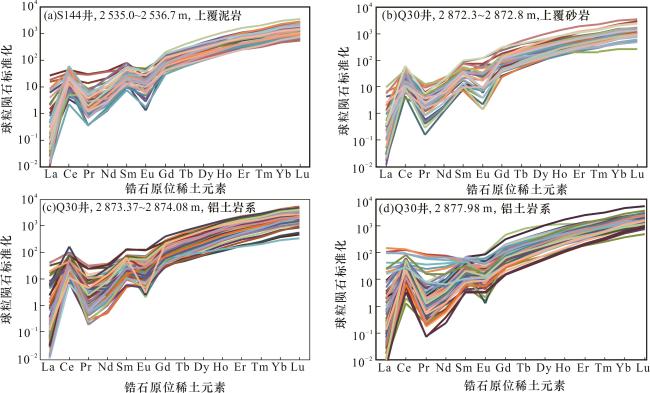
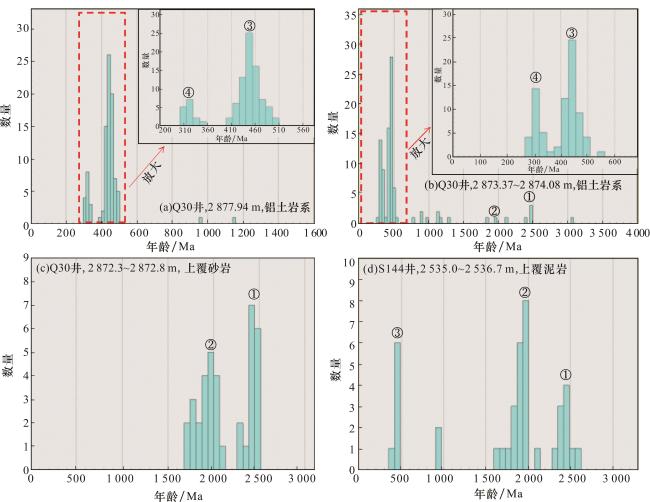
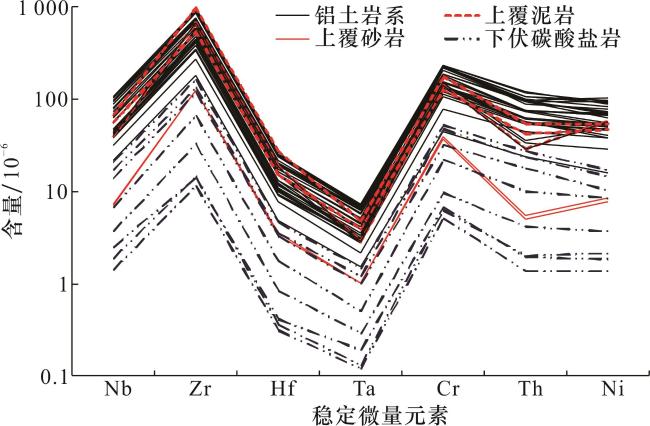
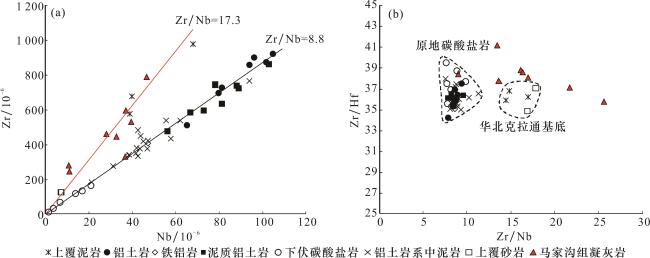
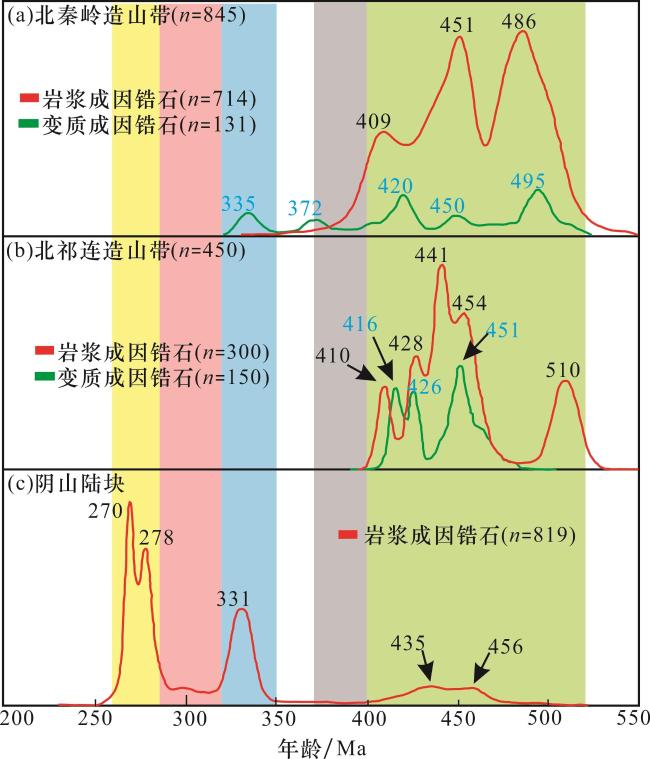
 甘公网安备 62010202000678号
甘公网安备 62010202000678号